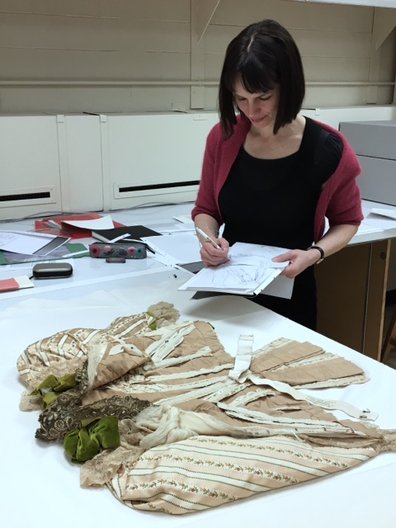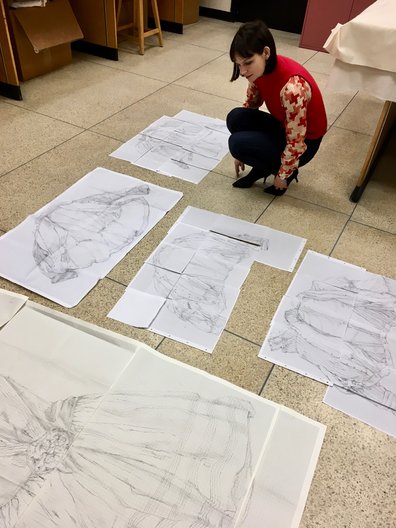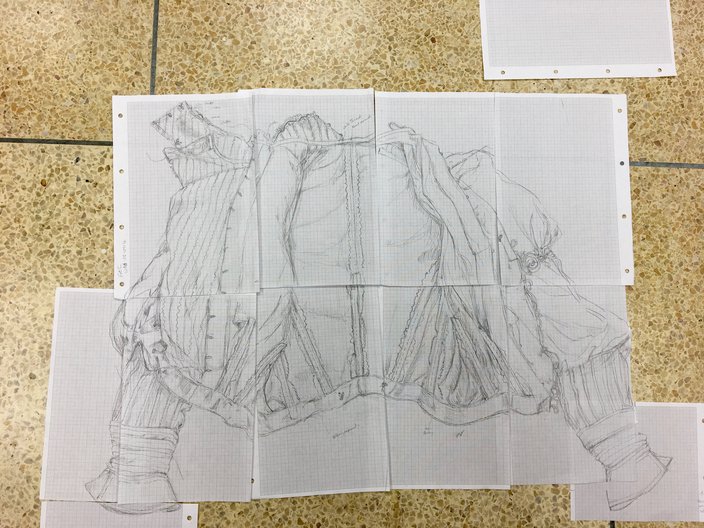1 May 2018
by Sarah Casey and Ingrid Mida
This is the first in a series of blog posts on Exquisite Corpses, a collaborative project by Sarah Casey and Ingrid Mida, which was supported by the British Council and the Arts Council through the Artists' International Development Fund (AIDF), September 2017-July 2018
In January 2018, Sarah Casey travelled to Toronto to spend an intensive ten days working alongside Ingrid Mida at Ryerson University. During that visit, Ingrid shared her approach to interpreting dress artifacts in The Dress Detective: The Practical Guide to Object-based Research (Bloomsbury Academic 2015). In April 2018, Ingrid travelled to Lancaster to visit Sarah’s studio and also visit Brantwood to examine John Ruskin’s clothing. This unique opportunity brought together two different disciplines to examine and creatively interpret historic dress for a contemporary audience in a project titled Exquisite Corpses.
What is Exquisite Corpses?
The title of the project Exquisite Corpses takes inspiration from the surrealist drawing game in which artists passed folded pieces of paper to each other to create a body. In such games, the results were random, unpredictable and often amorphous since the points of intersection were abrupt and discontinuous. This collaboration is viewed as an extended version of this surrealist game. We are passing ideas back and forth, with the discontinuous bits emerging from our differing perspectives and desired outcomes.
Clothing carries the imprints of its intimate relationship to the body, including the marks and stains of living and the rips, strains and tears of movement. There is poignancy in these marks that serve as a reminder of the person that once wore that garment. When a dress enters a museum or university study collection, it will never be worn again. To halt the inevitable disintegration of the textiles, the spaces that would be filled by the body are replaced with tissue and this can create an uncanny resemblance to a body on a table. This unsettling dialectic of presence/absence is a powerful reminder of the once living person that wore the garment.
This project is a collaborative effort to create work that draws on the material properties of dress artifacts in the Ryerson Fashion Research Collection at Ryerson University in Toronto. With Ingrid Mida acting as provocateur and poet and Sarah Casey undertaking drawings inspired by those provocations, we aim to create a body of work that gives material form and embodiment to the ephemeral nature of memory, time and disintegration.
The balance of the post will be a dialogue with each of us taking turns asking the other questions.
Ingrid: What interests you about drawing clothing?
Sarah: Like you, I am interested in how the close attention that drawing requires can untangle the threads of wear and tear to elicit a history from an inert object. There also seem so many qualities in clothing – its intimacy, sense of wear, human scale – that are echoed in forms of drawing. There is something uncanny about clothing that preserves a sense of an absent wearer. I am interested in how drawing, which is also a form of touching, can mirror this fragile sense of absent presence. A drawing made on a sheet of paper is like a skin. I view the page as a boundary surface onto which the marks of contact are deposited; these deposits or traces of touch are a drawing.
Ingrid: What motivated your first visit to the Ryerson Fashion Research Collection (FRC)?
Sarah: I was reading your book, The Dress Detective, a passage jumped out at me that described looking at artefacts as if drawing them. As an artist I had worked on several projects that were about the parallels between how we look and touch in drawing and that the way that researchers in other disciplines look and examine their subjects, including curation of historic dress. The Dress Detective was proof of the value of drawing in object-based research in fashion. I was so excited by this that I wrote to your co-author Alexandra Kim, who I had worked with at Kensington Palace and as you know, Alexandra put me in touch with you. In conversation, you and I realised how many ideas we shared in common. At that stage I did not dream that we would work together as closely as we are now.
Ingrid: What inspired you to begin drawing artefacts in the FRC?
Sarah: Well, in a word, you did! You have presented me with ideas and objects that would pique my creative curiosity – those that have turned up mysteriously in plastic bags, or garments that are called dead objects. How could I not be intrigued by this!
My previous projects drawing with dress collections involved garments that for one reason or another were overlooked or unseen in the collection, rarely examined and not publicly exhibited. The FRC was in itself an entire collection that was overlooked. As a research collection, it also allowed forms of handling and examination that are not possible in museum collections. This means new creative possibilities, for instance the ability to examine the insides of garments. It also offered access to artefacts that would not normally be accessioned in a museum collection such as those that are in such a poor state of repair they can barely be looked at.
Ingrid: Has working with me at the RFRC changed your approach in any way?
Sarah: So as you know, only pencil drawing is allowed in the archive for conservation reasons. I wanted to work within this limitation and see how I might challenge myself to work in a different way. Thinking of your ‘slow approach to seeing’, where drawing becomes a means of taking account of what is observed, I began to think of drawing as a kind of scanning. Like an x-ray machine would systematically scan a garment. It reminded me of map making, how a cartographer might survey terrain. I wondered what would happen if I were to try to map a whole garment in this way. In some ways, it seems to be a ridiculous thing to do because it is so time consuming. It is counter intuitive. No one would normally have the luxury of being able to spend days on end examining and drawing garments as you have allowed me to do. Archival appointments are usually for a morning or day at most. The extended period of time with you have allowed me to test working in a very different way. This in itself has presented new technical challenges, such as trying to get up close and draw at the same time means that I am bent over the artefact. I resolved this by working on sequential square sheets of graph paper that would match up. In this way the drawings became even more like maps.
Ingrid: What do you do with studies you make on site at the RFRC?
Sarah: These map drawings contain so much information for me to work with back in the studio they are like raw data. I have used them as templates for work that I have made in the studios, copying from them or even literally tracing over them onto different papers such as newsprint or lens tissue. I like tracing because it has a directness and is in many ways like touching.
Ingrid: How does my involvement with the project help you?
Sarah: Art making can often be a one sided thing – where the artist looks at a subject and creatively interprets it in line with their own agenda. I know in the past I have worked in this way. I see what we are doing as different. While I am holding the drawing instruments, much of the creative interpretation comes down to your input. The drawings have emerged through a back and forth – you show me a garment, I draw it, we discuss the garment it, I do some material tests trying to take account of the conceptual context, you respond to these tests, I make more and so on and eventually these have coalesced in to a coherent image.
Sarah: Why is drawing important in you practice as curator?
Ingrid: It takes time and patience in order to see the subtle clues of use, wear and alteration in reading a garment. Drawing is a systematic and active way of looking that encourages the researcher to slow down and look at the objects presented before them. Although it is fast and easy to take photographs, it is in drawing something that we actually see it. Drawing slows down looking. I call this method of seeing ‘The Slow Approach to Seeing’ and have written about it in my book The Dress Detective and elsewhere.
Sarah: Where does drawing fit in your practice as a curator?
Ingrid: I do not have the time to draw the objects under my care as keeper of the Ryerson Fashion Research Collection, but sometimes I will use drawing as a way to help me understand a complex method of construction or embellishment. At other times, I draw alongside my students during exercises that I have developed in order to help them learn to see. And if I am visiting another archive for research purposes, I use drawing as a method to help me see and record details of the garments that I am studying. Even a quick pencil sketch creates a mental space in which I slow down and look long enough to see more than I would otherwise see just from looking.
Sarah: What is interesting for you about working with an artist like me? What does this offer?
Ingrid: Many people assume that a dress collection is limited to the study of construction techniques or material culture research. However, I see the Ryerson Fashion Research Collection as a resource that can offer inspiration for a variety of creative and artistic practices. In working with an artist of your stature, I hope to bring attention to this once dormant collection and encourage others to harness its creative potential.
Sarah: How do you describe your role in our collaboration?
Ingrid: I see my role as provocateur in our collaboration. As I have come to know your work, I understand your creative process and have used that knowledge to identify artifacts that might interest you and challenge you to delve deeper into the issues of materiality and presence/absence that haunt these exquisite corpses within the archive.




